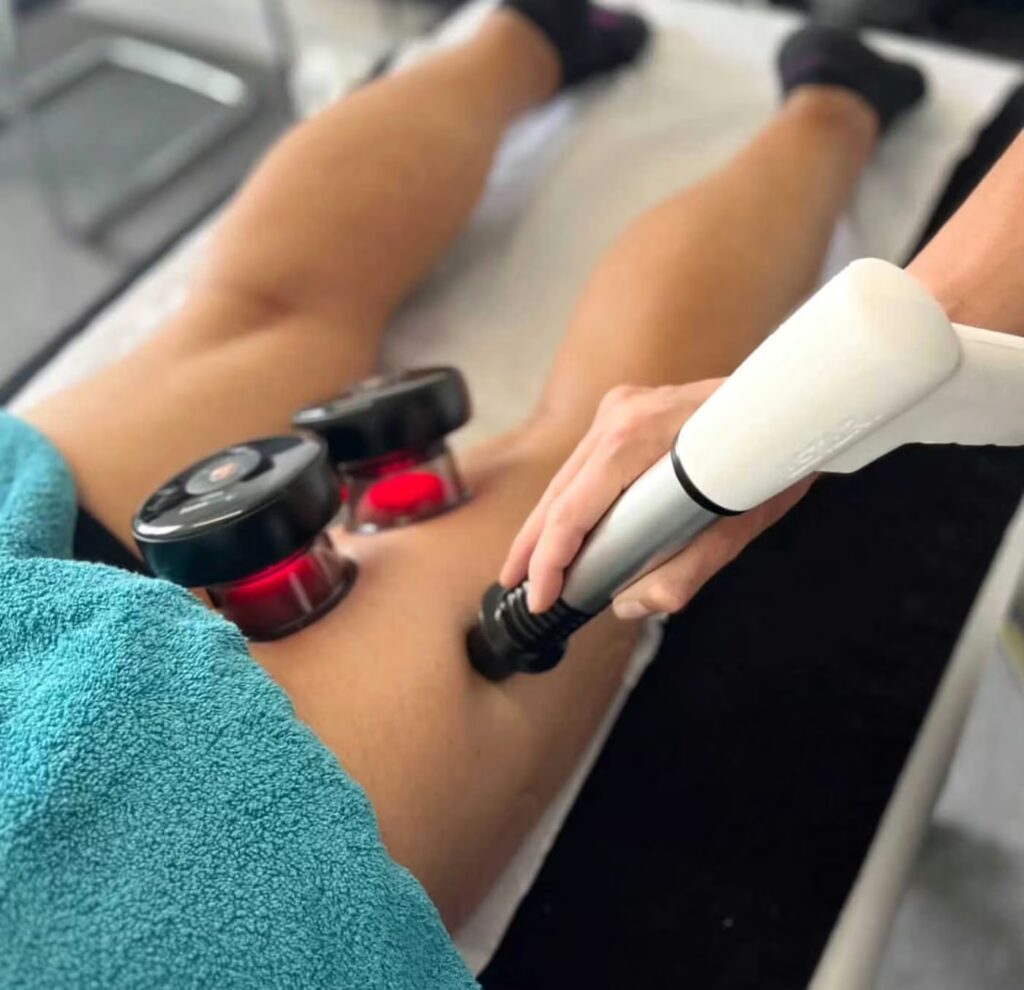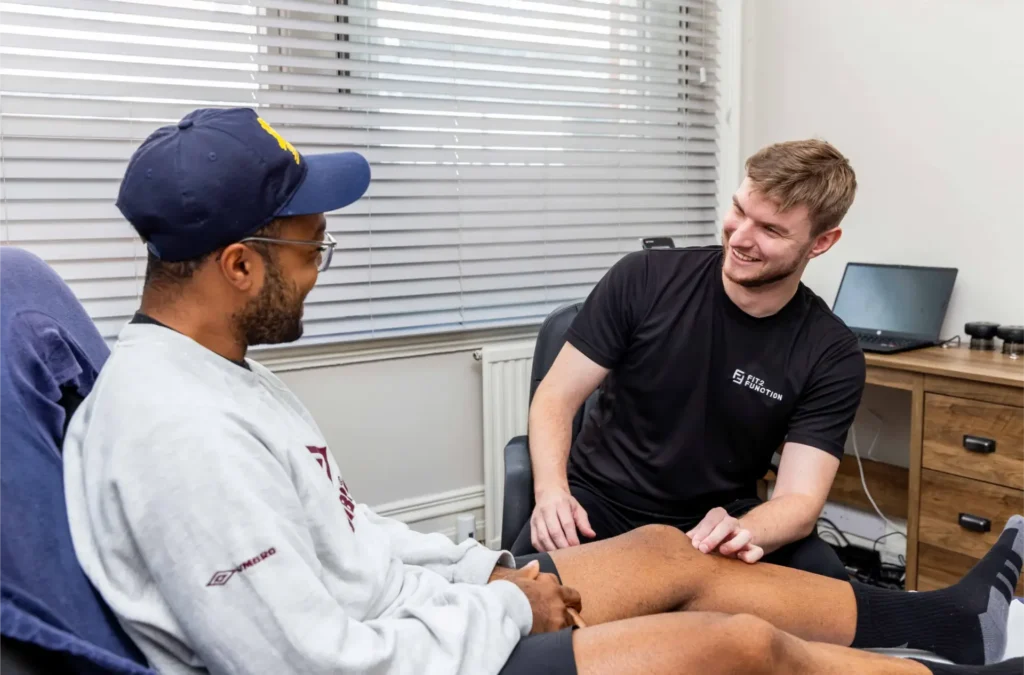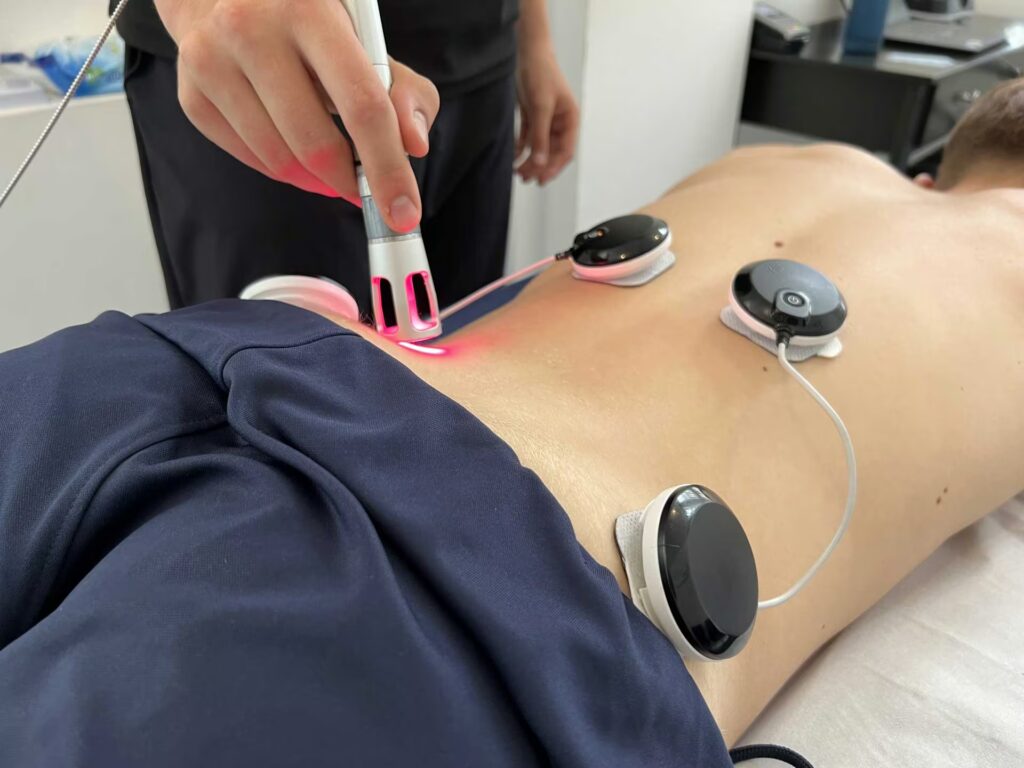How Can We Help Treat Sciatica
Sciatica describes irritation of the sciatic nerve, often producing radiating pain, numbness or weakness. We identify the underlying cause of your sciatica and work on reducing the pressure being applied to your sciatic nerve.
What you can expect:
- Thorough assessment of nerve function and movement patterns
- Hands-on techniques and nerve mobilisation to reduce irritation
- Advanced treatments reduce inflammation and reduce pain
- Strength and flexibility exercise to stabilise the spine and pelvis
- Practical education on posture, movement and symptom management

What Is Sciatica?
Sciatica refers to pain that originates from irritation or compression of the sciatic nerve, the longest nerve in the body. This nerve travels from your lower back, through the buttocks and down the back of each leg. When compressed (often by a bulging disc, tight muscle, or inflammation), it can trigger radiating pain, tingling, numbness or weakness in the leg. Sciatica is not a condition in itself, but a symptom of another issue in the spine or pelvis. It can affect people of any age, but is most common in those aged 30 to 60. At Fit2Function in Oxford Circus, we carefully assess the cause of your sciatica and create a structured, non invasive treatment plan to resolve symptoms and prevent recurrence.

What are the symptoms of Sciatica
The most typical symptom of sciatica is pain that radiates from the lower back or buttock down the back of one leg. The pain can vary from a mild ache to sharp, burning or electric shock like sensations. You may also experience tingling, numbness or weakness in the leg or foot. Symptoms often worsen with sitting, coughing, bending forward or prolonged standing. In severe cases, you might notice difficulty walking or reduced leg strength. Sciatica usually affects one side of the body, although the location and intensity can shift over time. At Fit2Function, we use a thorough assessment to pinpoint the source of the nerve irritation and tailor a treatment plan to your symptoms and stage of recovery.
What Are The Common Causes of Sciatica
Sciatica is typically caused by compression or irritation of the sciatic nerve in the lower spine or pelvis. Common causes include:
- Herniated or bulging discs
- Degenerative disc disease
- Spinal stenosis (narrowing of the spinal canal)
- Piriformis syndrome (where a muscle compresses the nerve in the buttock)
- Postural imbalances or poor movement patterns
Pregnancy related changes
In some cases, prolonged sitting, heavy lifting or sudden twisting motions can aggravate or trigger symptoms. At our Oxford Circus clinic, we assess the root cause of your sciatica, not just the symptoms, so we can apply the most effective and personalised treatment strategy for long lasting relief.

What Makes Us Different
Our team specialises in nerve-related conditions and offers advanced treatments that reduce symptoms quickly while addressing the underlying mechanical causes of your pain. We blend manual therapy, rehab and technology into clear, progressive treatment plans.
Why patients choose us:
- Experts in spinal nerve conditions and sciatica management
- 60-minute appointments for full assessment and treatment
- Tailored exercise plans to focus on your sciatica
- Advanced sciatica treatments with a 90% improvement in 6 weeks
- Central London clinic with easy access for follow-up care

Benefits Of Sciatica Treatment
With the right treatment, most people with sciatica experience a significant reduction in pain and a return to normal activity. Our clients often report improved mobility, less nerve related discomfort and a greater sense of control over their symptoms. Our treatments not only ease your current symptoms but also address the underlying cause of your pain.Whether you’re struggling to sit, sleep, work, or exercise, our structured recovery programmes are designed to restore strength, mobility and confidence. At Fit2Function in Oxford Circus, we aim to give you long-term relief from sciatica through expert care, movement education and lasting results.

What To Expect On Your First Visit
During your first visit, we’ll focus on understanding your injury, beginning treatment, and giving you the tools for recovery.
- Detailed discussion about your pain distribution, triggers and functional limitations.
- Clinical tests to assess nerve mobility, strength and spinal movement.
- Clear explanation of the likely cause and the planned approach moving forwards.
- Initial treatment focused on reducing nerve sensitivity and improving mobility.
- A personalised recovery plan with nerve-friendly exercises and prevention strategies.

How To Book Your First Appointment
Getting started is simple:
- Click the “Book An Appointment” button on this page.
- Select your preferred practitioner, service and time.
- Attend your first session and begin your recovery journey.
Prefer to chat first? Call us at 02071172076 or fill out the contact form at the bottom of the page and we’ll happily guide you through the process.

EXCELLENTTrustindex verifies that the original source of the review is Google. Very good laser treatment for lower back pain. Relieve a lot after the session.Trustindex verifies that the original source of the review is Google. Really impressed with George on my visit to F2F. Ankle has felt weak for a while now post sprain but already feeling better post treatmentTrustindex verifies that the original source of the review is Google. 5 stars is not enough for Anna! She is amazing.. not inky has she healed my shoulder she also healed my sons football injury! He is back playing in only a few weeks. ANNA also gave a plan which he can do along side his training to keep him fit! She is worth her weight in Gold!Trustindex verifies that the original source of the review is Google. I’ve been working with George at Fit to Function on and off over the past year, and I can’t recommend him enough. I was dealing with stubborn bicep tendinitis that just wouldn’t go away, but George completely sorted me out. Super friendly, knowledgeable, and genuinely helpful. I also love the new location — clean, professional, and easy to get to. If you’re struggling with any tendon issues, I highly recommend trying shockwave therapy here. It made a huge difference for me!Trustindex verifies that the original source of the review is Google. I’ve had some neck pain for a while, same with my right toe and thumb joint from football injuries. George and Conor were very welcoming. George really helped me in understanding the cause and telling me the right treatment before administering it. Completely recommend!Trustindex verifies that the original source of the review is Google. OMG amazing clinic, solved my issues and can run again. Thank you for your professionalism and attentiveness and such a warm atmosphere.Trustindex verifies that the original source of the review is Google. I went to Fit2Function for my ankle and had Anna Jancsurák as my Physiotherapist. She was amazing and so thoughtful and kind and very helpful in my rehabilitation. She explained everything very thoroughly and is very knowledgeable and showed me very helpful excersicesTrustindex verifies that the original source of the review is Google. I am currently being treated by Anna at Fit2Function for recurring knee issues. Anna is a fantastic physiotherapist: knowledgeable, professional, thorough and exceptional at her job. After only 3/6 sessions, and keeping up with physio outside of official appointments (don't skip this step), my legs are stronger and my knees no longer ache throughout my long, active workdays. I cannot recommend Anna enough, and I am safe in the knowledge that, should I ever have any body-related issues, I will be in safe hands with her.
Sciatica FAQs
How to relieve sciatica pain?
Gentle movement, applying heat and avoiding prolonged sitting can help in the short term. Physiotherapy techniques like manual therapy and targeted exercises provide longer term relief by addressing the root cause of your sciatica.
Can sciatica cause groin pain?
Typically, sciatica causes pain down the leg, but in some cases, related nerve or muscular issues may radiate discomfort toward the groin. A thorough initial assessment is needed to differentiate it from other conditions.
How long does sciatica last?
Mild cases may resolve in a few weeks, while more persistent sciatica can take 6-12 weeks or longer. Early treatment usually speeds up recovery and prevents chronic issues.
What is the best treatment for sciatica?
The best approach is a combination of hands on therapy, advanced treatments such as laser therapy, guided exercise rehabilitation and movement education. We tailor every treatment plan to your symptoms and goals.
How does a Physio help with sciatica?
Physiotherapists reduce nerve irritation through manual therapy, advanced treatments and guide you through exercises to restore strength and mobility, helping you recover faster and avoid future flare ups.